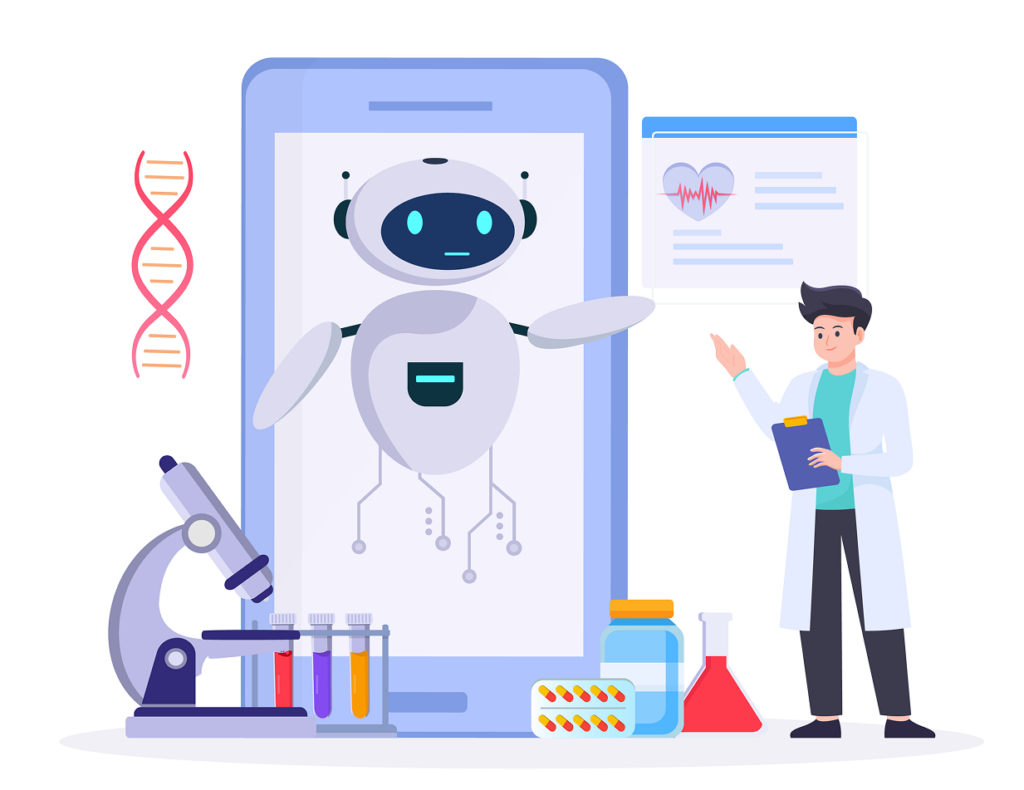AI for operational efficiency: Use cases, benefits, implementation, technologies and development
In the modern business landscape, Artificial Intelligence (AI) is emerging as a pioneering factor that propels operational efficiency to new heights. In the pursuit of competitiveness and sustainability, organizations are increasingly turning to AI as a strategic ally, streamlining processes and enhancing overall performance.As per Grand View Research, The global artificial intelligence market size was estimated at USD 196.63 billion in 2023 and is projected to grow at a CAGR of 36.6% from 2024 to 2030.

At its core, AI for operational efficiency relies on advanced algorithms and machine learning models to automate tasks, optimize workflows, and extract meaningful insights from vast datasets. This expedites routine processes and empowers businesses to make data-driven decisions, fostering a proactive approach to problem-solving. One of the pivotal ways AI contributes to operational efficiency is through predictive analytics. By analyzing historical data, AI systems can forecast trends, identify potential bottlenecks, and anticipate future challenges. This foresight allows businesses to preemptively address issues, minimize downtime, and allocate resources more judiciously. This article delves into various facets of operational efficiency, systematically exploring topics ranging from a comprehensive overview of operational efficiency and common challenges in traditional approaches to the pivotal role of AI in transforming operational processes. It provides insights into the applications of AI, the technologies driving its implementation, strategies to overcome challenges in adoption, and a forward-looking perspective on future trends and best practices for integrating AI seamlessly into operational workflows.

Impact of AI on enhancing operational efficiency
AI plays a crucial role in improving operational efficiency across numerous sectors. By automating routine and labor-intensive tasks, AI enables employees to concentrate on more strategic and valuable work, resulting in notable increases in productivity. This automation accelerates processes and minimizes errors, ensuring consistency and accuracy in operations.
AI can analyze large datasets in real-time, empowering organizations with deep insights and driving more informed and timely decision-making. For instance, AI can identify inefficiencies in workflows, suggest optimizations, and even predict future trends, enabling proactive management of resources and potential challenges. This proactive approach extends to maintenance and supply chain operations, where AI can forecast equipment failures or inventory needs, reducing downtime and preventing bottlenecks.
Moreover, AI facilitates innovation by expediting research and development cycles, allowing quicker iterations and faster time-to-market for new products. As AI systems can scale effortlessly, businesses can grow without the corresponding increase in operational costs, ensuring financial reassurance and maintaining efficiency as they expand.
AI transforms operations by making them smarter, more agile, and more cost-effective, positioning organizations to thrive in competitive and dynamic environments. This strategic integration of AI is increasingly becoming a critical driver of business success.
How does operational efficiency fit within the GenAI ecosystem?
Operational efficiency within the GenAI ecosystem, as depicted in the architecture, is integral to its effectiveness and success. It sits prominently within the application layer, which is the interface where the advanced capabilities of GenAI are applied to solve real-world problems.

- Enhanced productivity: By automating routine tasks, employees can focus on higher-value work, leading to increased productivity and innovation.
- Cost reduction: Operational efficiency tools can reduce the time and resources needed to perform certain tasks, leading to significant cost savings.
- Improved accuracy: AI and machine learning models can process data with a level of accuracy that reduces human error, leading to better decision-making and outcomes.
- Scalability: AI tools can handle an increasing volume of work without proportionally increasing staff, allowing companies to scale operations more effectively.
- Agility: With AI-driven operational efficiency, businesses can quickly adapt to changes in the market or demand, maintaining a competitive edge.
In the context of the GenAI ecosystem, operational efficiency is not just an internal tool but a product offering. For instance, LeewayHertz’s ZBrain, as an enterprise generative AI platform, potentially enhances sales enablement and customer support. It can automate and personalize interactions, analyze customer sentiment, and generate insights to drive sales strategies and improve customer service experiences.
Moreover, operational efficiency aligns closely with other layers in the ecosystem, like development companies and frameworks, which can provide the necessary tools and platforms to build and deploy efficient AI solutions. For example, a development company may utilize a framework like DeepSurge to create an AI application that helps businesses manage their sales pipeline more efficiently.

Common challenges in traditional operational practices and how AI addresses them
Businesses often face a range of challenges when utilizing traditional approaches to operational efficiency. These challenges can hinder their ability to adapt to changing market dynamics, meet customer expectations, and stay competitive. Here are some common challenges associated with traditional approaches:
Manual processes and paperwork
Challenge: Reliance on manual processes and paperwork often leads to inefficiencies, errors, and delays, with a higher risk of data entry mistakes and lost documents. This dependence requires extensive manual oversight, which can slow down operations and strain resources.
Solution: To tackle this obstacle, the integration of AI-powered automation tools is essential. These tools can streamline processes by automating repetitive tasks, thereby minimizing the necessity for manual involvement. For instance, document digitization and data extraction tools facilitate the conversion of paper-based documents into digital formats, enabling faster processing and enhanced accuracy.
Lack of integration between systems
Challenge: Many businesses continue to operate in siloed environments, with different departments using separate systems that lack effective communication. This lack of integration disrupts the seamless flow of information across the organization.
Solution: AI-driven integration platforms emerge as a viable solution to this problem. These platforms bridge disparate systems and data sources, facilitating seamless organizational communication and data exchange. Providing a unified view of operations enhances collaboration and decision-making capabilities across departments.
Limited data visibility and analytics
Challenge: Traditional approaches often lack advanced data analytics capabilities, making it challenging for businesses to extract meaningful insights from their data. This limitation can hinder their ability to make well-informed decisions and respond effectively to emerging trends.
Solution: Integrating AI-powered analytics tools offers a solution to this challenge. These tools leverage advanced algorithms to analyze large volumes of data swiftly and accurately, uncovering valuable insights and trends. Additionally, they provide predictive analytics capabilities, enabling organizations to anticipate future events and make well-informed decisions accordingly.
Resistance to change
Challenge: Employees and management may resist adopting new technologies and methods due to concerns about job displacement, unfamiliarity, or disruption to established routines. This reluctance can hinder the implementation of more efficient processes and technologies, impeding the organization’s growth and adaptability.
Solution: AI has the potential to significantly support change management initiatives. By providing comprehensive training and ongoing support for employees, showcasing the advantages of adopting new technologies, and delivering tailored recommendations, AI can encourage user acceptance and involvement, ultimately smoothing the transition process.
Inflexible organizational structure
Challenge: Traditional hierarchical structures can be rigid, making it difficult to adapt quickly to changes in the business environment. This rigidity often leads to slow decision-making, communication bottlenecks, and challenges in responding to market dynamics.
Solution: AI can optimize organizational structures based on real-time data and business objectives, identifying inefficiencies, streamlining workflows, and fostering collaboration across teams. This enhances organizational agility and responsiveness.
Limited scalability
Challenge: Traditional approaches may find it challenging to scale operations effectively, particularly when encountering higher demand or entering new markets. This difficulty can result in overstressed systems, longer lead times, and challenges in maintaining consistent service or product quality.
Solution: >AI-powered solutions empower organizations to swiftly and efficiently adjust resources and capacities in response to demand forecasts and performance metrics. This agility enables seamless operations scaling, ensuring optimal performance and increased customer satisfaction in dynamic business environments.
Dependency on legacy systems
Challenge: Businesses using outdated legacy systems often face challenges in upgrading or integrating new technologies. These systems may lack the functionalities needed for modern operational efficiency, resulting in suboptimal performance and higher maintenance costs.
Solution: AI can mitigate dependency on legacy systems by enabling seamless integration with modern technologies and automating routine tasks. Advanced analytics and predictive maintenance algorithms can enhance the functionality and longevity of existing systems. AI thus serves as a bridge between outdated infrastructure and contemporary operational needs, rejuvenating legacy environments without full system overhauls.
Regulatory compliance challenges
Challenge: Traditional approaches may struggle to keep up with evolving regulatory requirements, potentially leading to compliance issues. This can result in legal and regulatory challenges, including fines, legal disputes, and reputational damage.
Solution: AI-powered compliance solutions monitor regulatory changes, analyze their impact on business operations, and automate compliance processes. This practice ensures that organizations adhere to applicable laws and regulations, minimizing the possibility of facing penalties and damage to their reputation.
Comprehensive enterprise services & support
Exploring use cases: How to leverage AI for enhancing operational efficiency across diverse industries?
AI applications in operational efficiency span a wide range of industries, transforming how businesses streamline processes, optimize workflows, and make data-driven decisions. Here are applications of AI to enhance operational efficiency across various industries:
AI plays a transformative role in augmenting operational efficiency through various sophisticated applications in the manufacturing sector.
Factory automation
Factory automation, enhanced through AI, is vital for streamlining manufacturing processes. Intelligent systems embedded in machinery and operations reduce the necessity for manual control and cut down on errors. Consequently, efficiency and productivity see a marked improvement, especially in routine tasks such as material transportation and diagnostics.
Process automation
Process automation goes beyond the factory floor to include activities that affect overall production outcomes. AI algorithms are used to allocate resources, schedule tasks, and optimize processes based on demand and availability. This comprehensive approach improves operational efficiency and streamlines the manufacturing process, leading to smoother and more effective production.
Predictive maintenance
AI-based predictive maintenance uses sensors to monitor equipment and predict potential failures before they occur. Manufacturers can anticipate maintenance needs and prevent costly downtime by analyzing data and creating models. This proactive approach increases equipment availability and reduces maintenance costs.
Demand forecasting
AI algorithms analyze historical sales data and external factors to forecast demand accurately. Based on these forecasts, manufacturers can optimize inventory management and production schedules, reducing stockouts and excess inventory. Real-time data allows for quick adjustments to changing market conditions, improving responsiveness to customer demand.
Efficiency loss forecasting
AI algorithms analyze historical data to identify inefficiencies and forecast future deviations. By pinpointing the root causes of efficiency losses, manufacturers can implement targeted improvements to streamline processes and minimize downtime. This proactive approach enhances overall operational efficiency and performance.
Predictive analytics
One key application is predictive analytics, where AI algorithms can analyze large datasets to identify patterns and trends. This can help healthcare providers anticipate patient needs, optimize resource allocation, and minimize the likelihood of preventable complications. For instance, AI can be utilized to predict patient admission rates, enabling hospitals to allocate staff and resources more effectively, ultimately improving patient outcomes.
Streamline administrative tasks
AI-driven automation can streamline administrative tasks, allowing healthcare experts to focus more on patient care. Natural Language Processing (NLP) can be employed to automate documentation and transcription services, saving valuable time for physicians and reducing the risk of errors. AI-powered chatbots and virtual assistants enhance patient engagement by providing timely information, appointment reminders, and even preliminary medical advice.
Virtual health assistants
AI-powered chatbots and virtual health assistants streamline patient communication by offering efficient appointment scheduling, medication reminders, and personalized engagement. By automating routine tasks and providing timely assistance, AI enhances operational efficiency in healthcare, allowing staff to focus more on critical patient care tasks. This integration of AI technology not only improves patient satisfaction but also optimizes resource allocation and reduces administrative burdens, leading to a more streamlined and effective healthcare delivery system.
Demand forecasting
A key use of AI in the retail sector involves demand forecasting, a process where algorithms examine historical data, market trends, and external influences to predict product demand accurately. This enables retailers to optimize inventory management, minimize overstock or stockouts, and improve supply chain efficiency.
Inventory level optimization
AI assists in determining the optimal inventory level for each product, reducing excess inventory and minimizing the risk of obsolescence. This optimization enhances operational efficiency by allocating resources efficiently, reducing storage costs and improving cash flow.
Task automation
Automating repetitive tasks such as order reception and inventory replenishment frees employees to focus on more strategic activities. Streamlining operations improves productivity and reduces labor costs, improving operational efficiency and effectiveness.
AI-powered chatbot
AI-powered chatbots play a crucial role in streamlining retail operations. These intelligent virtual assistants adeptly handle routine customer inquiries, freeing up human resources to concentrate on more complex tasks.
Risk assessment
Risk assessment is a critical application in financial risk management, where AI algorithms are employed to analyze extensive datasets in real time. This enables the identification of potential risks and anomalies. By automating the risk assessment process, financial institutions can expedite decision-making, leading to more informed choices that reduce the probability of incurring financial losses.
Process optimization
Utilizing AI algorithms, fintech companies can automate and optimize various processes across their operations, such as loan processing, risk assessment, and customer support. AI-driven process optimization helps streamline workflows, reduce manual errors, and improve overall operational efficiency by completing tasks faster and more accurately.
Service quality improvement and customization
AI-powered analytics enable fintech companies to analyze large datasets to gain insights into customer behavior, preferences, and needs. By personalizing services based on customer insights obtained through AI-driven analytics, fintech companies can enhance service quality, increase customer satisfaction, and achieve operational efficiency by meeting the evolving demands of their target market effectively.
Compliance with regulatory measures
AI systems can assist fintech companies in monitoring and ensuring compliance with regulatory requirements across different regions and jurisdictions. By automating compliance processes and utilizing AI-powered tools for regulatory monitoring and reporting, fintech companies can mitigate the risk of non-compliance penalties and maintain operational efficiency while adhering to evolving regulatory standards.
Logistics and transportation
The logistics and transportation industry can significantly enhance operational efficiency through the strategic implementation of AI technologies.Route optimization
One key area where AI can make a substantial impact is route optimization. Advanced algorithms can analyze historical data, current traffic conditions, weather forecasts, and other relevant factors to identify the most efficient routes for transportation.
Predictive maintenance
AI-powered predictive maintenance is another critical aspect. By analyzing data from sensors and monitoring equipment on vehicles, AI can predict potential issues and schedule maintenance proactively, minimizing downtime and preventing costly breakdowns.
AI-driven demand forecasting
AI can transform inventory management within the logistics sector. ML algorithms can analyze historical sales data, monitor market trends, and factor in external influences to provide accurate predictions of future demand. This empowers companies to fine-tune their inventory management by optimizing stock levels, mitigating excess inventory, and lowering the likelihood of stockouts.
Streamline warehouse operations
AI enhances warehouse operations by optimizing inventory management, automating repetitive tasks such as order picking and sorting, improving demand forecasting accuracy, and optimizing warehouse layout and resource allocation. Utilizing machine learning algorithms and predictive analytics, AI empowers warehouses to optimize operations, minimize errors, and enhance efficiency. This results in significant cost reductions and heightened customer satisfaction as processes become streamlined and more accurate.
Legal research optimization
AI-powered tools enable legal professionals to conduct faster and more precise legal research by quickly analyzing vast amounts of legal documents, cases, and statutes. Natural Language Processing (NLP) algorithms facilitate the interpretation of legal language, providing lawyers with relevant and accurate information in a fraction of the time compared to traditional methods.
Document review and contract analysis automation
AI streamlines mundane tasks like document review and contract analysis by automating processes. Automating these processes decreases the time required for manual reviews and lowers the likelihood of human errors, enhancing the accuracy of legal documentation.
Predictive analytics for case outcome prediction
AI-driven predictive analytics analyze historical case data and identify patterns to provide insights into potential case outcomes. By leveraging machine learning models, legal professionals can make more informed decisions, improve risk assessment, and accurately predict case outcomes.
Virtual assistant for client interactions
AI-powered virtual assistants enhance client interactions by automating responses to common inquiries, scheduling appointments, and managing administrative tasks. This enables legal practitioners to concentrate on the more intricate and strategic aspects of their profession while ensuring effective communication and client management.
Predictive maintenance
AI algorithms analyze network data to predict potential equipment failures or network disruptions before they occur. This proactive approach allows telecom companies to schedule maintenance activities during off-peak hours, minimizing downtime and service interruptions. By identifying and addressing issues in advance, telecom companies can improve network reliability and reduce operational costs associated with emergency repairs.
Automated network optimization
ML algorithms continuously analyze network performance metrics and user behavior to optimize network configurations automatically. This automation streamlines adjusting network settings, such as bandwidth allocation and routing protocols, to ensure optimal performance and resource utilization. By dynamically adapting to changing network conditions, telecom companies can deliver a consistently high-quality service to customers while minimizing manual intervention from network engineers.
AI-powered customer support
Virtual assistants with natural language processing (NLP) capabilities handle routine customer inquiries and troubleshoot common issues without human intervention. These AI-driven support systems can provide immediate assistance to customers, reducing the need for human agents to handle repetitive tasks. Automating fundamental support functions allows telecom companies to boost response times, decrease support expenses, and elevate overall customer satisfaction.
Intelligent traffic management
AI-based traffic management systems analyze network traffic patterns and dynamically allocate resources to handle fluctuations in demand. This intelligent routing of network traffic helps optimize bandwidth usage and minimize congestion, ensuring a smooth and reliable service for users. By efficiently managing network traffic in real-time, telecom companies can improve network performance, reduce latency, and enhance the user experience.
Predictive analytics for resource planning
Predictive analytics algorithms analyze historical data and user trends to forecast future demand for network resources. Telecom companies can use these insights to optimize resource allocation, such as deploying additional capacity in high-demand areas or reallocating resources based on predicted usage patterns. By accurately predicting resource requirements, telecom companies can optimize infrastructure investments, minimize waste, and ensure optimal performance during peak usage.
AI plays a transformative role in augmenting operational efficiency through various sophisticated applications in the manufacturing sector.
AI-driven project management
Machine learning algorithms analyze historical project data to predict potential delays and optimize resource allocation. Construction companies can proactively adjust project timelines and resource allocation based on predictive insights to prevent bottlenecks and improve overall project efficiency. AI-enabled scheduling and resource management tools streamline project workflows, leading to better budget management and timely project completion.
Real-time safety monitoring
AI can monitor construction sites in real time, detect potential hazards, and ensure compliance with safety regulations. AI-powered sensors continuously analyze construction site activities, identifying safety risks such as unauthorized personnel access, equipment malfunctions, or unsafe working conditions. AI contributes to maintaining a safe working environment by promptly alerting site managers and workers to potential hazards, allowing them to take proactive measures to mitigate risks and ensure safety.
Predictive maintenance for equipment
AI-driven predictive maintenance systems analyze equipment data to forecast potential failures and maintenance needs. By monitoring factors such as equipment usage, performance metrics, and environmental conditions, AI can predict maintenance issues before they occur. Proactively addressing equipment maintenance requirements minimizes downtime, improves equipment reliability, and optimizes construction operations.
Autonomous construction vehicles and drones
AI-powered autonomous vehicles and drones are used for site surveying, material transportation, and aerial monitoring. These autonomous systems leverage AI algorithms for navigation, obstacle detection, and path planning, reducing the need for manual intervention. By automating repetitive tasks and streamlining workflows, AI-enabled autonomous vehicles and drones improve construction site efficiency, accuracy, and safety.
Applications of AI in business operations for enhanced operational efficiency
AI can profoundly impact operational efficiency in business processes by optimizing operations. Here’s how AI influences different business processes:

Automation of routine tasks
AI automates repetitive tasks such as data entry, scheduling, and invoice processing. This reduces the need for manual intervention, decreases error rates, and speeds up operations, freeing employees to focus on higher-value tasks.

Enhanced data management
AI systems streamline data management by automatically organizing, cleaning, and integrating data from multiple sources. This improves data accuracy and accessibility, enabling more efficient decision-making and reducing the time spent on data-related tasks.

Process optimization
AI analyzes workflows to identify inefficiencies and recommend improvements. For instance, AI can optimize production schedules and reduce downtime in manufacturing by predicting equipment maintenance needs, thereby enhancing overall process efficiency.

Real-time decision-making
AI delivers real-time analytics and insights that enhance operational efficiency, enabling businesses to adapt swiftly to changing conditions. With AI, organizations can monitor processes continuously, detect inefficiencies, and make adjustments on-the-fly. This agility streamlines operations, reduces downtime, and optimizes resource allocation, ensuring businesses respond promptly to operational challenges and maintain smooth, efficient workflows.

Predictive analytics
AI leverages historical data to forecast future trends and demand. This enables businesses to optimize inventory levels, manage resources more efficiently, and plan for future needs, reducing waste and ensuring smoother operations.

Efficient supply chain management
AI enhances supply chain efficiency by predicting demand, optimizing inventory, and improving logistics. AI-driven tools help streamline procurement processes, manage supplier relationships, and reduce lead times, resulting in cost savings and improved delivery performance.

Customer service automation
AI-powered chatbots and virtual assistants streamline operational efficiency by managing routine customer inquiries and support requests. This automation accelerates response times and reduces the workload on human agents, enabling them to address more complex issues. As a result, overall service efficiency improves, and resources are utilized more effectively, leading to smoother and better customer service operations.

Quality control
AI enhances operational efficiency by monitoring production quality in real time and detecting defects and anomalies as they occur. This continuous oversight ensures that issues are identified and addressed immediately, reducing the risk of defective products reaching customers. By automating quality checks, AI improves product consistency, decreases waste, and streamlines the production process, leading to more efficient and reliable operations.

Resource allocation
AI optimizes resource allocation by analyzing real-time data and predictive models to ensure efficient use of workforce and equipment. This minimizes bottlenecks and prevents underutilization, leading to smoother operations and enhanced productivity. By aligning resources with actual needs and forecasts, AI helps businesses streamline processes and maintain high operational efficiency.

Financial management
AI automates financial processes like expense tracking, budgeting, and fraud detection, which boosts operational efficiency by streamlining financial workflows. This automation reduces manual oversight, minimizes errors, and accelerates financial reporting, leading to more efficient financial operations and better resource management.
Enhancing operational efficiency with GenAI
Generative AI is transforming operational efficiency by driving measurable improvements in speed and resource utilization while also enabling more agile processes, enhanced customer experiences, and greater employee satisfaction across industries. With GenAI’s capabilities, organizations can streamline operations, reduce inefficiencies, and improve resource allocation. This leads to faster execution, cost savings, and greater adaptability to changing business environments, resulting in a more agile and productive organization
Here is how GenAI enhances the operational efficiency of a process workflow in different stages.
| Steps Involved | Sub-Steps Involved | Role of GenAI |
|---|---|---|
| Define Goals and Objectives |
| Analyzes historical data to identify areas for improvement. Generates potential goals based on industry trends and best practices. Assists in quantifying the impact of achieving each goal. Identifies alignment with strategy. |
| Analyze Current Operations |
| Maps and visualizes workflows quickly. Detects inefficiencies and delays in operations. Analyzes resource utilization patterns efficiently. Automates data collection for accurate insights. Provides industry-specific comparisons and metrics. |
| Identify Resources |
| Quickly identifies and categorizes needed resources. Evaluates existing resources and usage patterns. Detects shortages and suggests alternatives. Predicts resource demand based on trends. Optimizes allocation for maximum efficiency. |
| Develop an Action Plan |
| Suggests clear, data-driven goals. Generates actionable steps based on insights. Recommends task assignments for optimal efficiency. Creates realistic timelines using predictive analysis. Suggests resource distribution for each task. |
| Steps Involved | Sub-Steps Involved | Role of GenAI |
|---|---|---|
| Identify Automation Opportunities |
| Identifies repetitive tasks for automation. Evaluates tasks suitable for automation. Provides insights on cost and efficiency gains. Recommends tools needed for automation integration. |
| Select and Implement Technology |
| Assists in selecting the most appropriate technology for specific use cases. Provides guidance on implementation and configuration of the chosen technology. |
| Integrate Systems and Data |
| Maps data and system compatibility needs. Accelerates system integrations by automating code, suggesting data mappings, and simplifying API understanding. Validates and synchronizes data across platforms. Detects and resolves integration issues quickly. Tracks and optimizes real-time data exchanges. |
| Train and Support Users |
| Generates customized, role-specific learning content. Automates session planning and reminders. Offers interactive, AI-driven user tutorials. Analyzes feedback to improve training programs. |
| Steps Involved | Sub-Steps Involved | Role of GenAI |
|---|---|---|
| Analyze Process Performance |
| Automates data gathering from multiple sources. Compares metrics to predefined performance targets. Detects process bottlenecks and inefficiencies. Discovers actionable insights from historical data. Recommends optimization based on real-time analysis. |
| Identify and Eliminate Waste |
| Helps in detecting redundant or non-essential tasks. Monitors resource use for potential waste. Recommends high-impact areas for waste removal. Suggests targeted optimizations for reducing waste. |
| Steps Involved | Sub-Steps Involved | Role of GenAI |
|---|---|---|
| Define and Track KPIs |
| Suggests key metrics based on goals. Continuously monitors KPIs in real-time. Identifies trends and deviations in metrics. Recommends updates based on performance data. |
| Analyze Performance Data |
| Automates data collection from various sources. Generates visualizations for easier interpretation. Detects anomalies and patterns in data. Offers recommendations based on data analysis. |
| Identify and Implement Improvements |
| Recommends high-impact areas for focus. Suggests and supports implementation strategies. Tracks results and adjusts strategies as needed. |
How does DeepSurge’s generative AI platform enhance operational efficiency?

AI-driven fleet management in logistics
ZBrain offers a holistic solution designed to enhance operational efficiency and maximize outcomes, including increased productivity, customer satisfaction, and profitability, through an automated process. In the initial phase of operational efficiency analysis, ZBrain collects data, including financial statements, operational metrics, customer transaction data, regulatory records, and market indicators from various sources. Following data collection, ZBrain employs automated Exploratory Data Analysis (EDA) to ensure data validity and consistency through validation and cleaning procedures, a crucial step for error prevention and maintaining accuracy in operational insights. ZBrain employs advanced embedding techniques, transforming textual data into numerical representations to capture contextual relationships, enhancing data retrieval and analysis efficiency for precise insights and enriched decision-making. When a user requests an operational efficiency analysis report, ZBrain extracts relevant data based on the query’s criteria. This data and the user’s inquiry undergo processing by the chosen Large Language Model (LLM) to generate a well-structured report encompassing operational insights and efficiency recommendations. After report generation, ZBrain refines the report using parsing techniques, extracting pertinent insights for optimal quality and effectiveness. Seamlessly integrating data processes, ZBrain delivers a comprehensive operational efficiency analysis report, empowering finance and banking professionals with valuable insights for informed strategies.
DeepSurge’s AI development services for operational efficiency
At DeepSurge, we design and craft customized AI solutions to enhance operational efficiency across various industries. Our strategic AI/ML consulting enables businesses to harness artificial intelligence for streamlined processes, improved productivity, and optimized resource management.
Our expertise in developing Proof of Concepts (PoCs) and Minimum Viable Products (MVPs) allows firms to preview the potential impacts of AI tools in real operational scenarios. This approach ensures that the solutions are both effective and tailored to the specific needs of the sector. We work closely with clients to develop AI solutions that automate routine tasks, enhance workflow efficiency, and improve operational decision-making.
Our work in generative AI significantly transforms routine operational tasks such as data entry, report generation, and process monitoring. Automating these processes frees teams to focus on more strategic roles, thereby enhancing overall productivity and efficiency.
By fine-tuning large language models to understand industry-specific terminology and processes, LeewayHertz enhances the accuracy and relevance of AI-driven communications and analyses. This fine-tuning improves the clarity and reliability of automated data handling and operational reporting.

Our AI solutions development expertise
AI solutions development for operational efficiency typically involves creating systems that enhance decision-making, automate routine tasks, and streamline workflow processes. These solutions integrate key components such as data aggregation technologies, which compile and analyze operational data from diverse sources. This comprehensive data foundation supports predictive analytics capabilities, allowing for the forecasting of operational needs that inform strategic decisions. Additionally, machine learning algorithms are employed to optimize resource allocation and process efficiency, ensuring that operations are lean and responsive to demand fluctuations. These solutions often cover areas like supply chain management, inventory control, quality assurance, and customer service enhancement. Overall, AI solutions in operational efficiency aim to optimize business operations, reduce costs, and improve service delivery.
AI agent/copilot development for operational efficiency
DeepSurge develops custom AI agents and copilots that enhance various operational functions, enabling companies to save significant time and resources while facilitating faster and more effective decision-making. Here’s how they help:
Process automation
- Automate routine tasks such as data entry, scheduling, and workflow management to improve efficiency and reduce manual errors.
- Implement smart workflows that streamline operations and eliminate bottlenecks.
- Monitor processes and systems, identifying issues before they escalate.
Resource management
- Utilize predictive analytics to forecast resource needs and optimize allocation based on real-time data.
- Automate inventory management to ensure optimal stock levels, reducing waste and preventing shortages.
- Monitor and optimize energy consumption, reducing costs and environmental impact.
Performance monitoring
- Provide real-time insights into operational performance, enabling quick adjustments and informed decision-making.
- Track key performance indicators (KPIs) and generate detailed reports, facilitating performance improvement.
- Detect and address anomalies in operational processes, preventing disruptions and maintaining smooth operations.
Supply chain optimization
- Predict demand trends and optimize supply chain operations accordingly.
- Plan and optimize delivery routes, reducing transportation costs and improving delivery times.
- Monitor and evaluate supplier performance to ensure timely and quality deliveries.
Quality control
- Monitor and control manufacturing processes, ensuring optimal output.
- Analyze equipment data to predict maintenance needs and schedule preventive maintenance, reducing downtime.
Customer service enhancement
- Provide instant support and resolve common customer queries, enhancing customer satisfaction.
- Analyze customer feedback to gauge sentiment and improve service quality.
- Tailor customer interactions based on historical data and preferences.
Risk management
- Identify and assess potential risks in operations, enabling proactive risk management.
- Implement automated compliance checks to ensure adherence to industry regulations and standards.
- Predict potential incidents and implement preventive measures to maintain operational stability.
Data management
- Integrate data from various sources into a unified platform, ensuring comprehensive visibility and control.
- Automate data cleaning and validation processes to ensure data accuracy and reliability.
- Utilize advanced analytics to extract actionable insights from operational data, driving informed decision-making.
Strategic advantages of implementing AI for operational efficiency
Enhanced speed and accuracy
AI systems operate at unparalleled speeds with remarkable accuracy. Tasks that may take humans significant time can be executed swiftly by AI algorithms, reducing processing times and minimizing the likelihood of errors.
Improved resource allocation
AI-driven data analysis helps organizations optimize resource allocation. Whether dealing with manpower, inventory, or finances, AI algorithms can analyze current trends and historical data to suggest the most efficient resource distribution for optimal performance.
Real-time data analysis
AI enables real-time data analysis, providing organizations with instant insights into their operations. This capability is invaluable for quick decision-making, allowing businesses to respond promptly to changing conditions or emerging opportunities.
Cost reduction and resource optimization
AI contributes to significant cost reductions by automating processes, minimizing waste, and optimizing resource usage. Operational efficiency through AI allows organizations to do more with fewer resources, leading to substantial long-term savings. However, the extent of cost reduction and resource optimization may vary depending on various factors such as implementation, industry, and specific use cases.
Personalized customer experiences
Utilizing AI technologies like machine learning and natural language processing empowers businesses to tailor customer experiences, fostering not just satisfaction but also cultivating increased customer loyalty and repeat business.
Proactive issue resolution
AI systems can identify anomalies and patterns indicative of potential issues or disruptions. This proactive approach empowers organizations to address problems before they escalate, reducing downtime and maintaining a smooth operational flow.
Scalability and adaptability
AI solutions are scalable and adaptable to changing business needs. Whether a company is experiencing growth or needs to pivot its operations, AI technologies can flexibly accommodate varying workloads and challenges.
Enhanced decision-making
AI provides decision-makers with valuable insights based on data analysis. This data-driven decision-making process ensures that choices are informed, strategic, and aligned with the organization’s objectives.
Competitive advantage
AI enables organizations to deliver products or services more quickly, at lower costs, and with higher quality compared to competitors, providing a significant competitive edge in the market.
Customer satisfaction
AI-driven operational efficiency ensures timely delivery, high product quality, and responsive customer service, leading to improved customer experiences and increased satisfaction.
Adaptability to change
AI-powered operations enable organizations to quickly adapt to changing market conditions, technology advancements, and regulatory requirements, ensuring resilience and agility in the face of uncertainty.
Future trends in AI for operational efficiency
As technology progresses, the future promises exciting possibilities for artificial intelligence to transform how businesses optimize their operational processes. Here are some future trends in AI that can help enhance operational efficiency:
Define clear objectives and goals for AI implementation
Clearly outline what you want to achieve with AI in your operations. Whether it’s improving efficiency, cutting costs, or enhancing customer satisfaction, having well-defined goals is crucial.
AI for sustainable operations
AI technologies will be employed to optimize resource usage and reduce environmental impact. This includes energy-efficient operations, waste reduction, and sustainable practices across various industries.
AI-driven continuous improvement
AI systems will increasingly focus on continuous improvement. Through machine learning algorithms, systems will analyze past performance, identify areas for enhancement, and autonomously implement optimizations, leading to ongoing efficiency gains.
Best practices for implementing AI in operational processes
Implementing AI in operational processes requires a strategic and thoughtful approach to ensure success, efficiency, and positive outcomes. Here are some best practices for implementing AI in operational processes:
Define clear objectives and goals for AI implementation
Clearly outline what you want to achieve with AI in your operations. Whether it’s improving efficiency, cutting costs, or enhancing customer satisfaction, having well-defined goals is crucial.
Understand the business processes
Get a deep understanding of your existing business processes. Identify where AI can help, such as automating tasks or optimizing workflows. This understanding guides how AI aligns with your operational needs.
Ensure data quality and accessibility
Ensure your data is high quality, relevant, and accessible. Implement data governance practices to maintain data integrity, security, and compliance.
Choose the right AI technology
Choose AI technologies that align with your business goals and operational requirements. Consider factors like task complexity, available data, and scalability of the chosen AI solution.
Ensure transparency and explainability
For AI models impacting decision-making, ensure transparency and explainability. Knowing how AI reaches conclusions builds trust and facilitates collaboration between humans and AI.
Prioritize ethical implications
Address ethical considerations related to AI, such as privacy, bias, and fairness. Establish ethical guidelines to ensure responsible AI use and prevent unintended consequences.
Iterate and learn from feedback
AI implementation is an iterative process. Collect feedback from stakeholders and users to refine and improve AI models and processes continuously.
Ensure scalability and integration
Plan for scalability as operational needs evolve. Ensure AI solutions seamlessly integrate with existing systems and processes for a smooth transition.
Monitor and evaluate performance
Implement monitoring to track AI system performance in real-time. Regularly evaluate the impact on efficiency, user satisfaction, and other key metrics for ongoing improvements.
Stay informed on regulatory compliance
Stay updated on relevant regulations and standards in your industry. Ensure AI implementation complies with legal requirements to avoid legal complications.
Promote a culture of innovation
Encourage a culture that embraces innovation and supports employees in exploring new ways of working with AI.
Establish a robust security framework
Implement strong cybersecurity measures to protect AI systems and the data they handle. This includes encryption, access controls, and regular security audits.
Endnote
AI emerges as a catalyst for profound change in navigating operational complexities. The applications and benefits of AI in operational contexts, signifying a paradigm shift where efficiency is not just optimized but redefined.
AI’s impact extends beyond automating routine tasks; it serves as a powerful ally in data analytics, predictive decision-making, and adaptive learning. Organizations embracing AI are not just streamlining processes; they are fortifying themselves against the challenges of a rapidly evolving business environment. The ability of AI to sift through vast datasets, uncover patterns, and generate actionable insights empowers businesses to make informed decisions in real-time.
Looking ahead, AI’s future for operational efficiency promises continuous innovation. As technology advances, so too will the capabilities of AI, ushering in an era where adaptability and responsiveness become synonymous with operational excellence. Whether in manufacturing, healthcare, finance, or any other industry, the integration of AI is not a luxury but a strategic imperative for those aiming not just to survive but to thrive in an ever-changing landscape. The organizations that embrace AI today are laying the foundation for agility, resilience, and sustained success in the dynamic markets of tomorrow.

Insights
AI in inventory management: Redefining inventory control for…
AI redefines inventory management, streamlining operations, predicting demand, and optimizing stock control with unrivaled precision and efficiency.
AI in trend analysis: Predicting the pulse of…
In today’s fast-paced, data-driven world, deciphering patterns and trends is more crucial than ever, serving as a compass for organizations and individuals…
A guide to computer vision: Techniques, operational mechanics,…
Computer vision is a field of artificial intelligence that enables computers and systems to derive meaningful insights from digital images, videos, and…





